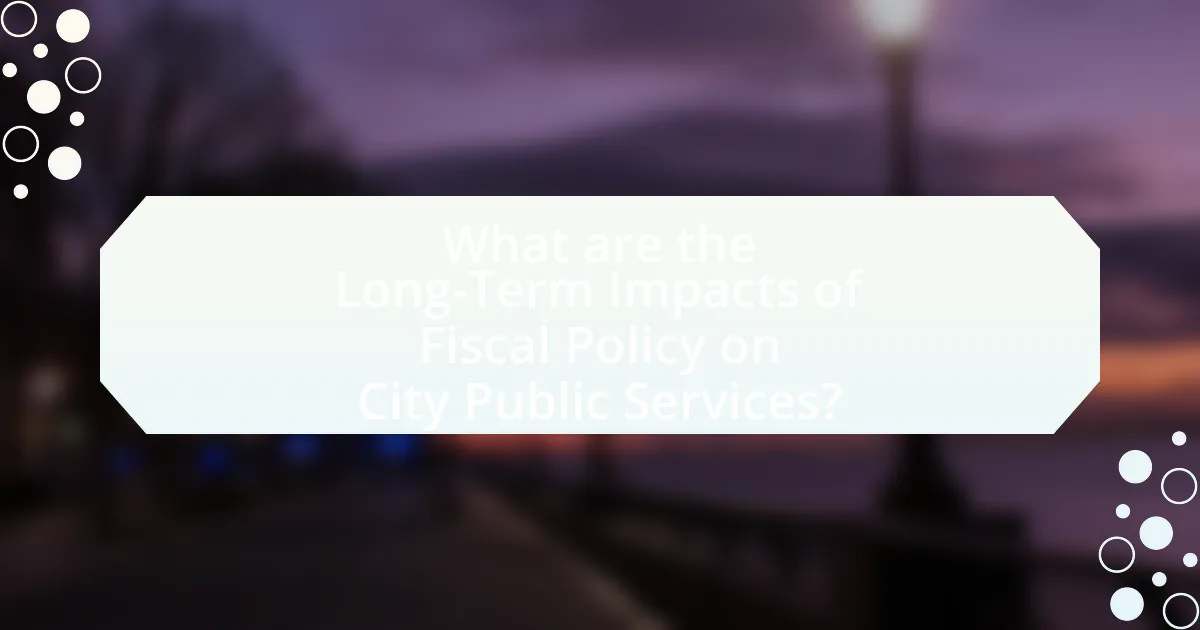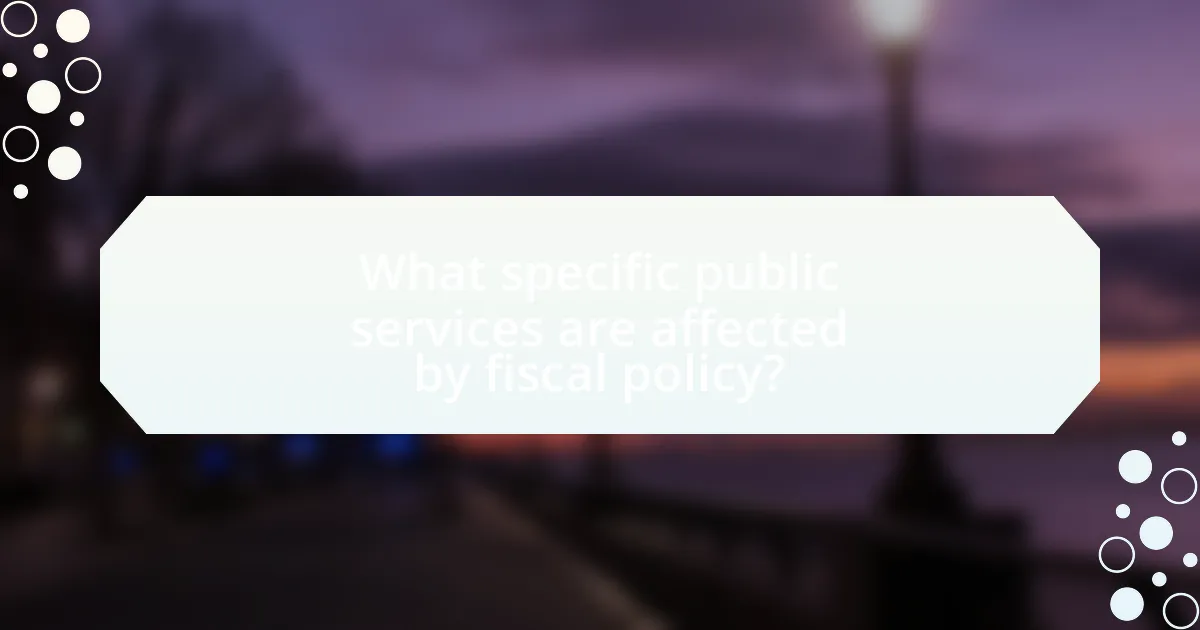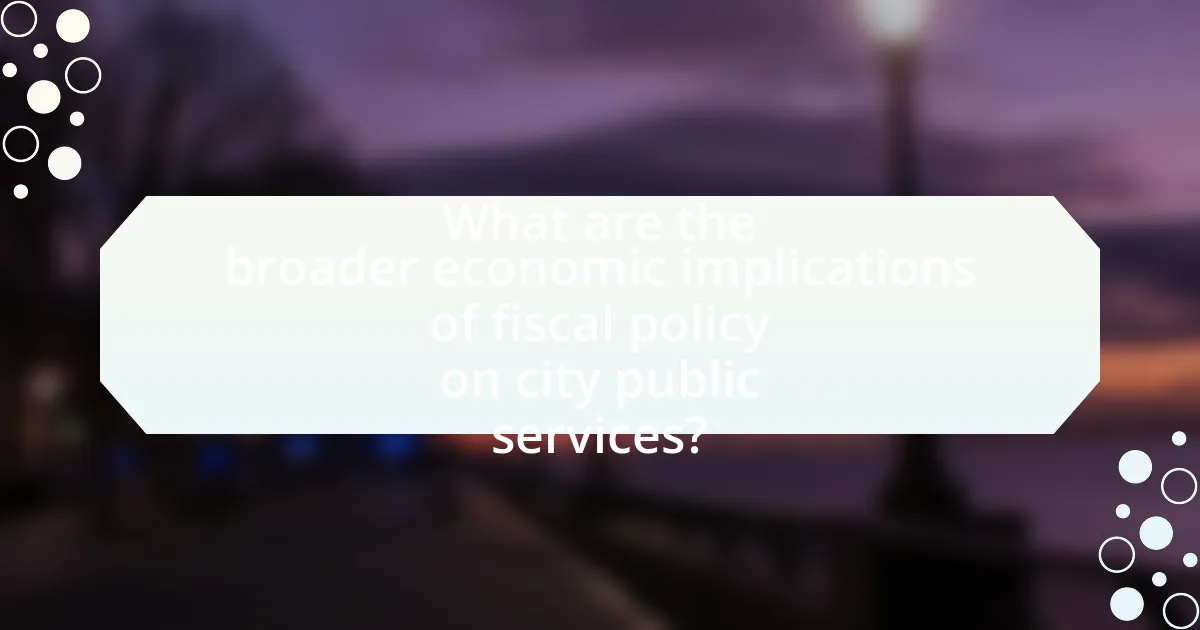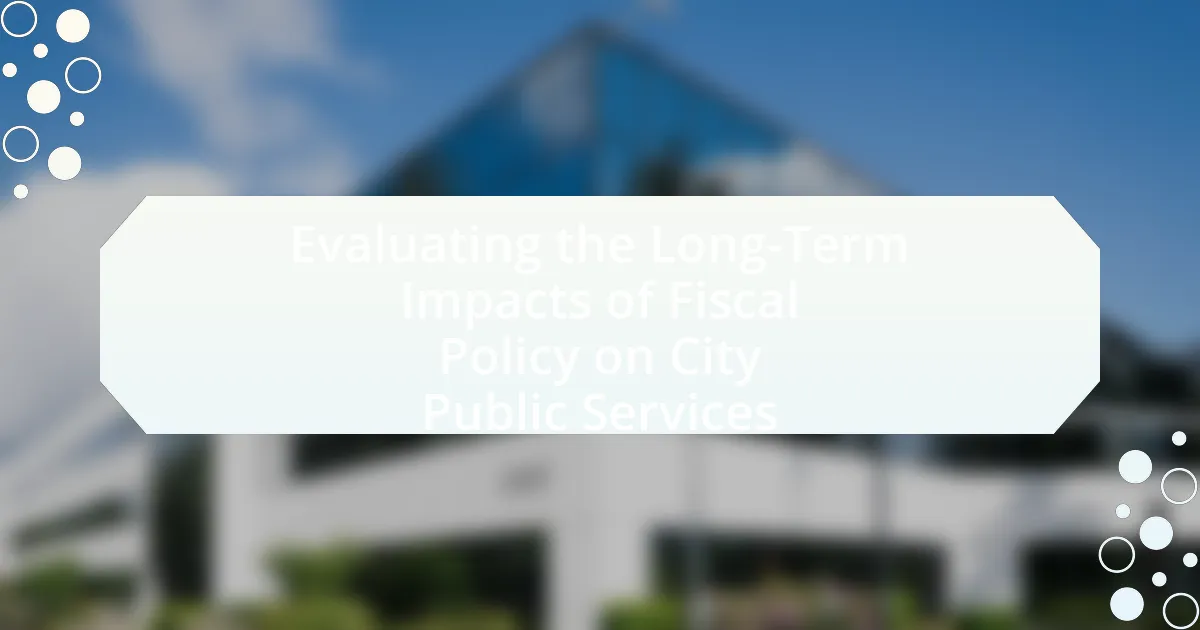The article evaluates the long-term impacts of fiscal policy on city public services, focusing on how government spending and taxation decisions influence service quality, availability, and funding stability. It discusses the effects of expansionary and contractionary fiscal policies on essential services such as education, healthcare, and infrastructure, highlighting historical examples and data-driven insights. Key components of fiscal policy, methodologies for evaluation, and the implications for economic growth and social equity are also examined, emphasizing the importance of long-term assessments in shaping effective public service delivery and resource allocation.

What are the Long-Term Impacts of Fiscal Policy on City Public Services?
Long-term impacts of fiscal policy on city public services include changes in service quality, availability, and funding stability. For instance, when a city implements expansionary fiscal policies, such as increased public spending, it can enhance public services like education and infrastructure, leading to improved community outcomes. Conversely, contractionary fiscal policies, characterized by budget cuts, can result in diminished service levels and increased strain on existing resources. Historical data from cities that have experienced significant fiscal adjustments, such as Detroit during its bankruptcy, illustrate that reduced funding can lead to service degradation, increased response times for emergency services, and overall lower quality of life for residents. Thus, fiscal policy decisions directly shape the effectiveness and sustainability of public services in urban environments.
How does fiscal policy influence the funding of public services in cities?
Fiscal policy directly influences the funding of public services in cities by determining government revenue and expenditure levels. When a city implements expansionary fiscal policies, such as increasing public spending or reducing taxes, it can enhance funding for essential services like education, healthcare, and infrastructure. Conversely, contractionary fiscal policies, which involve cutting spending or raising taxes, can lead to reduced funding for these services. For example, during the 2008 financial crisis, many cities faced budget shortfalls due to decreased tax revenues, resulting in cuts to public services. This illustrates how fiscal policy decisions shape the financial resources available for urban public services, impacting their quality and accessibility.
What are the key components of fiscal policy that affect public service funding?
The key components of fiscal policy that affect public service funding are government revenue generation, expenditure allocation, and budgetary policies. Government revenue generation primarily involves taxation, where income, sales, and property taxes provide the necessary funds for public services. Expenditure allocation determines how these funds are distributed across various public services, such as education, healthcare, and infrastructure. Budgetary policies, including deficit spending and surplus management, influence the sustainability of funding for these services over time. For instance, in the United States, local governments rely heavily on property taxes, which accounted for approximately 72% of local tax revenue in 2020, directly impacting the funding available for public services.
How do changes in fiscal policy impact the allocation of resources to public services?
Changes in fiscal policy directly influence the allocation of resources to public services by altering government revenue and expenditure patterns. For instance, an increase in government spending, often resulting from expansionary fiscal policy, typically leads to enhanced funding for public services such as education, healthcare, and infrastructure. Conversely, contractionary fiscal policy, characterized by reduced spending or increased taxes, can result in budget cuts that negatively affect the availability and quality of these services. Historical data from the 2008 financial crisis illustrates this impact; countries that implemented stimulus packages saw improved public service funding, while those that adopted austerity measures faced significant reductions in service provision.
Why is it important to evaluate the long-term impacts of fiscal policy?
Evaluating the long-term impacts of fiscal policy is crucial because it informs decision-makers about the sustainability and effectiveness of government spending and taxation strategies. Long-term evaluations reveal how fiscal policies affect economic growth, public service delivery, and social equity over time. For instance, a study by the International Monetary Fund in 2021 highlighted that countries with well-evaluated fiscal policies experienced more stable economic growth and improved public service outcomes compared to those without such evaluations. This evidence underscores the necessity of assessing fiscal policy impacts to ensure that resources are allocated efficiently and equitably, ultimately enhancing the quality of city public services.
What are the potential consequences of neglecting long-term evaluations?
Neglecting long-term evaluations can lead to significant misallocations of resources and ineffective policy decisions. Without these evaluations, city officials may fail to identify the sustained impacts of fiscal policies on public services, resulting in continued funding for ineffective programs or the discontinuation of successful initiatives. Historical data shows that cities that implemented long-term evaluations, such as New York City’s fiscal policy assessments, were able to adjust their budgets effectively, improving service delivery and community satisfaction. In contrast, cities that ignored long-term evaluations often faced budget shortfalls and declining public trust, as evidenced by studies indicating that lack of accountability in fiscal management correlates with decreased public service quality.
How can long-term evaluations inform future fiscal policy decisions?
Long-term evaluations can inform future fiscal policy decisions by providing data-driven insights into the effectiveness and efficiency of past policies. These evaluations analyze trends over extended periods, revealing the impacts of fiscal measures on public services, economic growth, and social equity. For instance, a study by the National Bureau of Economic Research found that cities that implemented long-term fiscal evaluations were able to adjust their budgets more effectively, resulting in improved public service delivery and enhanced economic outcomes. By understanding the long-term consequences of fiscal policies, policymakers can make informed decisions that optimize resource allocation and address community needs more effectively.
What methodologies are used to evaluate the impacts of fiscal policy?
Econometric modeling, case studies, and simulations are the primary methodologies used to evaluate the impacts of fiscal policy. Econometric modeling employs statistical techniques to analyze historical data and establish relationships between fiscal policy changes and economic outcomes, allowing researchers to quantify effects such as GDP growth or employment changes. Case studies provide in-depth analysis of specific instances where fiscal policy was implemented, offering insights into real-world applications and outcomes. Simulations use computational models to predict the effects of fiscal policy under various scenarios, helping policymakers understand potential future impacts. These methodologies collectively enable a comprehensive assessment of fiscal policy’s effectiveness and its long-term implications for city public services.
What quantitative methods are commonly employed in fiscal policy evaluations?
Commonly employed quantitative methods in fiscal policy evaluations include econometric modeling, regression analysis, and simulation techniques. Econometric modeling allows researchers to analyze the relationships between fiscal policy variables and economic outcomes, providing insights into the effectiveness of policies. Regression analysis is frequently used to estimate the impact of fiscal measures on various indicators, such as employment and GDP growth, by controlling for other influencing factors. Simulation techniques, such as dynamic stochastic general equilibrium (DSGE) models, enable the assessment of potential future impacts of fiscal policies under different scenarios. These methods are validated by their widespread application in empirical studies, demonstrating their effectiveness in analyzing fiscal policy outcomes.
How do qualitative assessments contribute to understanding fiscal policy impacts?
Qualitative assessments enhance the understanding of fiscal policy impacts by providing in-depth insights into the experiences and perceptions of stakeholders affected by these policies. These assessments capture nuanced information that quantitative data may overlook, such as community sentiment, service delivery challenges, and the effectiveness of policy implementation. For instance, interviews and focus groups with city residents can reveal how fiscal decisions influence public services like education and healthcare, highlighting areas of success and concern. This qualitative data complements quantitative metrics, such as budget allocations and service usage statistics, by contextualizing the numbers and illustrating the real-world implications of fiscal policies.

What specific public services are affected by fiscal policy?
Fiscal policy specifically affects public services such as education, healthcare, transportation, and public safety. Changes in government spending and taxation directly influence the funding available for these services. For instance, increased government expenditure can enhance educational resources, while tax cuts may lead to budget constraints that affect healthcare services. Historical data shows that during economic downturns, cities often face reduced fiscal capacity, resulting in cuts to essential services like public safety and infrastructure maintenance.
How does fiscal policy impact education services in cities?
Fiscal policy significantly impacts education services in cities by determining the allocation of financial resources for public schools and educational programs. When a city implements expansionary fiscal policies, such as increased government spending or tax cuts, it often leads to higher funding for education, resulting in improved facilities, better teacher salaries, and enhanced educational resources. Conversely, contractionary fiscal policies, which involve budget cuts or tax increases, can lead to reduced funding for education, negatively affecting student outcomes and access to quality education. For instance, a study by the Center on Budget and Policy Priorities found that states that increased education funding during economic recovery saw better student performance metrics, highlighting the direct correlation between fiscal policy and educational quality.
What funding mechanisms are influenced by fiscal policy in education?
Funding mechanisms influenced by fiscal policy in education include state funding formulas, property taxes, and federal grants. State funding formulas allocate resources based on factors such as student enrollment and local wealth, directly reflecting fiscal policy decisions. Property taxes serve as a primary revenue source for local school districts, and changes in fiscal policy can affect tax rates and assessments. Federal grants, such as Title I funding, are also contingent on fiscal policy, as they depend on federal budget allocations and priorities. These mechanisms demonstrate how fiscal policy shapes the financial landscape of education, impacting resource distribution and equity among schools.
How do changes in education funding affect student outcomes over time?
Changes in education funding significantly impact student outcomes over time by influencing academic performance, graduation rates, and overall educational attainment. Research indicates that increased funding leads to smaller class sizes, better teacher salaries, and enhanced educational resources, which collectively contribute to improved student learning experiences. For instance, a study by the National Bureau of Economic Research found that a 10% increase in per-pupil spending can lead to a 7% increase in high school graduation rates and a 10% increase in college enrollment rates. These findings demonstrate that sustained investment in education funding correlates with positive long-term outcomes for students.
What role does fiscal policy play in public health services?
Fiscal policy plays a crucial role in public health services by determining the allocation of government resources to health programs and infrastructure. Through budgetary decisions, fiscal policy influences funding levels for hospitals, preventive care, and health education initiatives, which directly affect the quality and accessibility of health services. For instance, a study by the World Health Organization indicates that countries with higher public health spending, often influenced by fiscal policy, experience better health outcomes, such as lower infant mortality rates and increased life expectancy. Thus, effective fiscal policy is essential for enhancing public health services and improving overall population health.
How does funding allocation for public health change with fiscal policy adjustments?
Funding allocation for public health is directly influenced by fiscal policy adjustments, as changes in government spending and taxation can either increase or decrease available resources. For instance, when a government implements expansionary fiscal policies, such as increased public spending or tax cuts, funding for public health programs typically rises, allowing for enhanced services and infrastructure. Conversely, contractionary fiscal policies, which involve spending cuts or tax increases, often lead to reduced funding for public health, resulting in potential service limitations and negative health outcomes. Historical data from the 2008 financial crisis illustrates this dynamic; many cities faced budget shortfalls that led to significant cuts in public health funding, adversely affecting community health initiatives and access to care.
What are the long-term health outcomes associated with fiscal policy changes?
Long-term health outcomes associated with fiscal policy changes include improved access to healthcare, enhanced public health infrastructure, and reduced health disparities. For instance, increased government spending on health services can lead to better healthcare facilities and more comprehensive health programs, which ultimately improve population health metrics. Research indicates that regions with higher public health investments experience lower rates of chronic diseases and better overall health outcomes, as evidenced by studies showing a correlation between fiscal policy and health improvements in various populations.
How is infrastructure development influenced by fiscal policy?
Infrastructure development is significantly influenced by fiscal policy through government spending and taxation decisions. When a government increases public spending on infrastructure projects, it directly stimulates economic growth, creates jobs, and enhances public services. For example, the American Recovery and Reinvestment Act of 2009 allocated approximately $48 billion for transportation infrastructure, which led to improved roads and bridges, demonstrating how fiscal policy can drive infrastructure development. Conversely, austerity measures that reduce public spending can hinder infrastructure projects, leading to deterioration of public services and economic stagnation. Thus, fiscal policy shapes the scale and quality of infrastructure development, impacting long-term urban growth and public service efficiency.
What types of infrastructure projects are most affected by fiscal policy decisions?
Transportation infrastructure projects are most affected by fiscal policy decisions. These projects, including roads, bridges, and public transit systems, rely heavily on government funding and budget allocations. For instance, during economic downturns, governments may reduce spending on transportation projects, leading to delays and cancellations. Conversely, expansionary fiscal policies can increase investment in these areas, as seen in the American Recovery and Reinvestment Act of 2009, which allocated significant funds for transportation infrastructure to stimulate the economy. This demonstrates the direct correlation between fiscal policy and the viability and progress of transportation infrastructure projects.
How do fiscal policies shape the sustainability of urban infrastructure?
Fiscal policies shape the sustainability of urban infrastructure by determining the allocation of public funds and investment priorities. These policies influence the level of funding available for infrastructure projects, which directly impacts their maintenance, development, and resilience. For instance, cities that prioritize sustainable practices through fiscal incentives can enhance their infrastructure’s longevity and efficiency, as seen in the implementation of green building codes and renewable energy initiatives. Research indicates that cities investing in sustainable infrastructure can reduce long-term operational costs by up to 30%, demonstrating the financial benefits of aligning fiscal policies with sustainability goals.

What are the broader economic implications of fiscal policy on city public services?
Fiscal policy significantly influences city public services by determining the allocation of resources and funding levels. When a city implements expansionary fiscal policy, such as increased government spending or tax cuts, it can enhance public services like education, infrastructure, and healthcare, leading to improved quality of life and economic growth. Conversely, contractionary fiscal policy, characterized by reduced spending or tax increases, can lead to budget cuts in essential services, negatively impacting community welfare and economic stability. Historical data shows that cities with robust fiscal policies often experience lower unemployment rates and higher public satisfaction, as seen in cities like San Francisco and Seattle, which have invested heavily in public services through progressive taxation and strategic spending.
How does fiscal policy affect economic growth in urban areas?
Fiscal policy significantly influences economic growth in urban areas by determining government spending and taxation levels. Increased government expenditure on infrastructure, education, and public services can stimulate local economies by creating jobs and enhancing productivity. For instance, a study by the National Bureau of Economic Research found that every dollar spent on public infrastructure can generate up to $2.50 in economic output. Conversely, higher taxes can reduce disposable income, potentially slowing consumer spending and investment. Therefore, the balance and effectiveness of fiscal policy directly impact urban economic growth through its effects on public investment and consumer behavior.
What is the relationship between public service funding and local economic development?
Public service funding directly influences local economic development by providing essential services that enhance community well-being and attract businesses. Adequate funding for public services such as education, infrastructure, and public safety creates a conducive environment for economic activities, leading to job creation and increased investment. For instance, a study by the National Bureau of Economic Research found that cities with higher public service investments experienced faster economic growth and lower unemployment rates, demonstrating a clear link between effective public service funding and robust local economies.
How do fiscal policies impact employment rates in cities?
Fiscal policies significantly impact employment rates in cities by influencing government spending and taxation, which in turn affect economic activity and job creation. For instance, increased government spending on infrastructure projects can lead to job creation in construction and related sectors, while tax incentives for businesses can stimulate hiring. According to a study by the National Bureau of Economic Research, cities that implemented expansionary fiscal policies during economic downturns experienced a 1.5% higher employment growth rate compared to those that did not. This demonstrates that effective fiscal policies can enhance employment opportunities and reduce unemployment rates in urban areas.
What are the social implications of fiscal policy on public services?
Fiscal policy significantly influences public services by determining the allocation of government resources, which directly affects service availability and quality. For instance, increased government spending can enhance public services such as education, healthcare, and infrastructure, leading to improved social outcomes like higher literacy rates and better health indicators. Conversely, austerity measures or reduced fiscal spending can result in service cuts, negatively impacting vulnerable populations and exacerbating social inequalities. Research by the International Monetary Fund indicates that fiscal consolidation can lead to a decline in public service quality, particularly in low-income areas, highlighting the critical link between fiscal policy decisions and social equity in public service provision.
How does fiscal policy influence equity in access to public services?
Fiscal policy influences equity in access to public services by determining the allocation of government resources and funding priorities. Through progressive taxation and targeted spending, fiscal policy can enhance access for marginalized communities, ensuring that essential services like education, healthcare, and infrastructure are equitably distributed. For instance, research indicates that cities employing progressive tax systems tend to invest more in public services that benefit low-income populations, thereby reducing disparities in access. This approach is supported by data showing that areas with higher public investment in services experience improved outcomes in health and education for disadvantaged groups, highlighting the critical role of fiscal policy in promoting equity.
What are the long-term social outcomes of fiscal policy decisions on vulnerable populations?
Long-term social outcomes of fiscal policy decisions on vulnerable populations include increased inequality, reduced access to essential services, and diminished social mobility. For instance, austerity measures often lead to cuts in social programs, which disproportionately affect low-income families, resulting in higher poverty rates and limited educational opportunities. Research by the International Monetary Fund indicates that fiscal consolidation can exacerbate income inequality, as the burden of budget cuts typically falls on those least able to absorb them. Additionally, studies show that reduced public spending on health and education can lead to long-term negative effects on the well-being and economic prospects of vulnerable groups, perpetuating cycles of disadvantage.
What best practices can cities adopt for evaluating fiscal policy impacts?
Cities can adopt several best practices for evaluating fiscal policy impacts, including establishing clear metrics for assessment, utilizing data analytics, and engaging stakeholders in the evaluation process. Clear metrics, such as economic growth rates, employment changes, and public service delivery efficiency, provide a framework for measuring the effects of fiscal policies. Data analytics enables cities to analyze trends and outcomes effectively, allowing for evidence-based decision-making. Engaging stakeholders, including community members and local businesses, ensures that diverse perspectives are considered, enhancing the evaluation’s relevance and accuracy. These practices are supported by studies indicating that cities employing structured evaluation frameworks see improved fiscal outcomes and better alignment of policies with community needs.
How can cities implement effective monitoring and evaluation frameworks?
Cities can implement effective monitoring and evaluation frameworks by establishing clear objectives, utilizing data-driven methodologies, and engaging stakeholders throughout the process. Clear objectives provide a foundation for what the framework aims to achieve, ensuring alignment with fiscal policies impacting public services. Data-driven methodologies, such as performance indicators and statistical analysis, enable cities to assess the effectiveness of their services quantitatively. Engaging stakeholders, including community members and service providers, fosters transparency and accountability, enhancing the relevance and acceptance of the evaluation outcomes. For instance, cities like New York have successfully employed these strategies, leading to improved public service delivery and informed policy adjustments based on comprehensive evaluations.
What strategies can enhance stakeholder engagement in the evaluation process?
To enhance stakeholder engagement in the evaluation process, implementing transparent communication strategies is essential. Clear and consistent communication fosters trust and encourages stakeholders to participate actively. For instance, regular updates on evaluation progress and findings can keep stakeholders informed and invested in the process. Additionally, involving stakeholders in the design and implementation phases of the evaluation ensures their perspectives are considered, which can lead to more relevant and actionable outcomes. Research indicates that participatory approaches, where stakeholders contribute to decision-making, significantly improve engagement levels and satisfaction with the evaluation process.

Leave a Reply